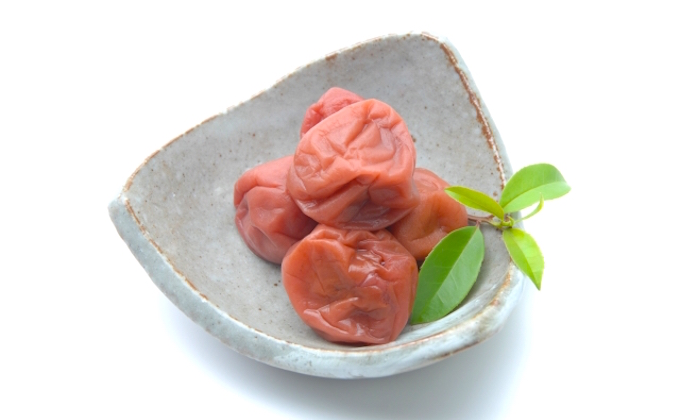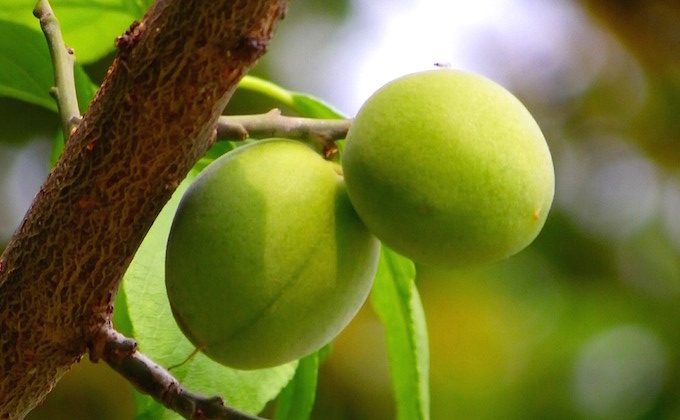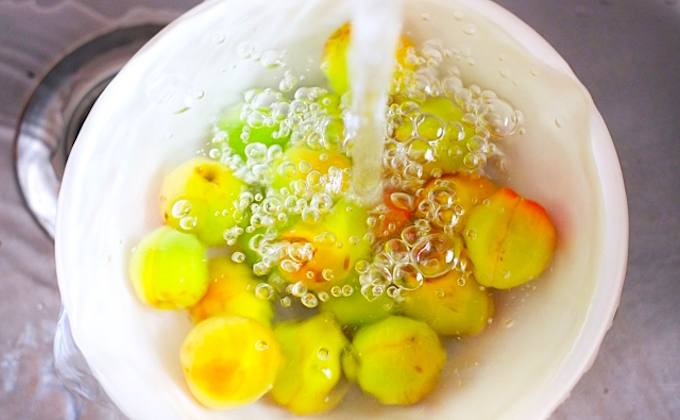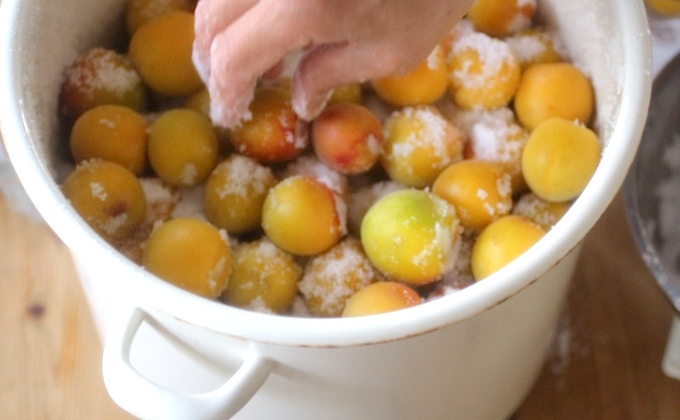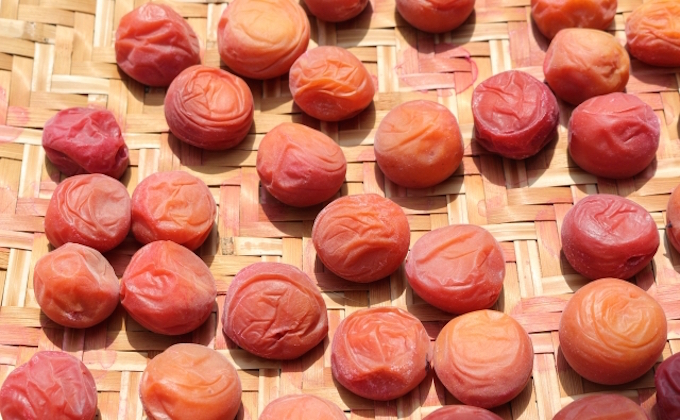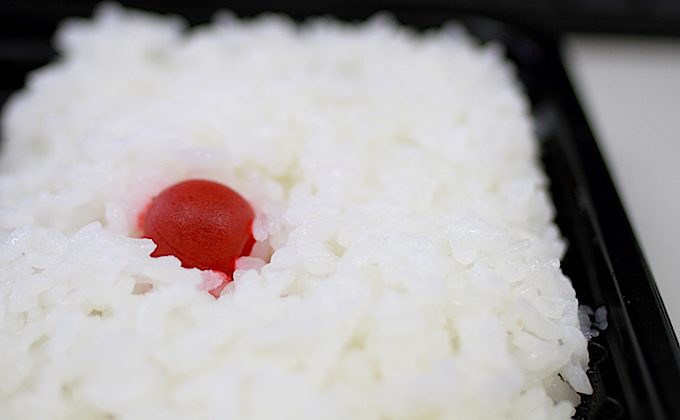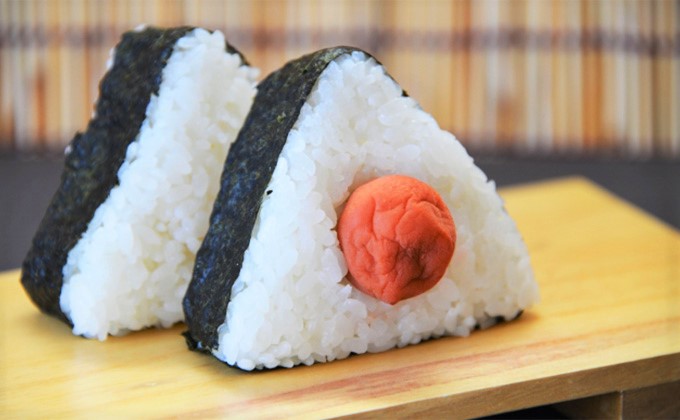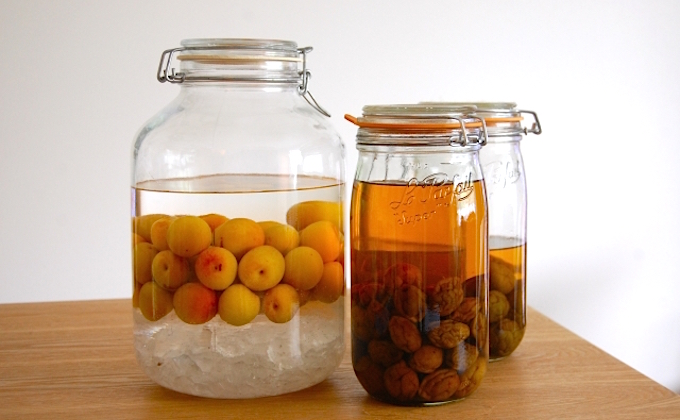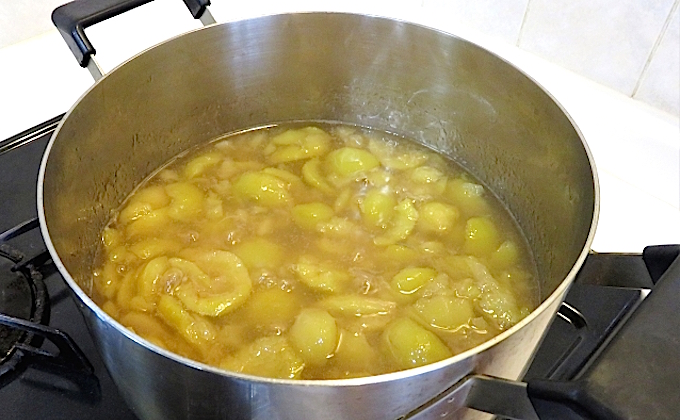TRG Info and Advice
Umeboshi (Salt-Preserved Ume Plums)
The History of Umeboshi
Ume plums originated in China, where they are considered a medicinal plant. In a chronicle of ancient Chinese medicinal herbs, ume plums are divided into three categories: baijitsu (fruit of the plum), u-bai (“crow” ume plum) and hakubai (white ume plum). About 1,500 years ago, u-bai, which are green plums cured and dried until “black as a crow,” were brought to Japan.
During the Nara Period (714-794), ume plums were consumed raw, like pears and peaches, and in the Heian Period (794-1185), the nobility planted ume plum trees in their gardens for aesthetic purposes. Over time, the health benefits of ume gradually began to be recognized, and umeboshi, salted plums, were invented in order to preserve the fruit for long periods of time.
The oldest medical book in Japan describes some of the positive effects of ume plums, including bringing down a fever, stopping nausea and curbing diarrhea. Another record shows that Emperor Murakami recovered from the plague by drinking tea made with umeboshi and kombu kelp.
In the Kamakura Period (1185-1333), Zen priests used umeboshi as an accompaniment for tea. Umeboshi were, also, served as a lucky food item in a meal called “ouban,” a feast held for occasions like departures for the frontier or the triumphant return of samurai warriors.
In the Sengoku Period (1491-1573), warriors carried with them a bag of food containing “umeboshigan” (umeboshi balls), made by kneading the flesh of umeboshi with ground brown rice powder and crystal sugar powder. They used these sweet and sour balls to catch their breath during long, harsh battles or to sterilize fresh water. Also, the saliva that emerged from simply thinking of the balls’ intense sourness helped quench their thirst. At first, a majority of people did not have access to umeboshi, but during the Edo Period (1603-1867) pickled ume plums began to be widely consumed, even in ordinary households. People drank “fuku-cha” (lucky tea), that is hot tea with umeboshi in it, on festive occasions such as New Year’s Eve, New Year’s Day and Setsubun (the last day of winter). This tradition of including umeboshi in the festivities continues today.
From years ten to twenty of the Meiji Period, infectious diseases such as cholera and dysentery spread nationwide in Japan, and a new light was shed on the sterilizing power of umeboshi to prevent and cure communicable diseases. During the First Sino-Japanese War and Russo-Japanese War, soldiers who had contagious diseases were given extracts of ume plum flesh, which was made by boiling down green ume juice.
What is umeboshi?
Umeboshi are made from ripe ume plums (a species of Prunus mume of the family Rosaceae) which are salted and sun-dried. Ume plums which are not sun-dried are called umezuke (salt-pickled ume plums).
The color is mostly dark red, but ume plums range widely in size and texture.
Umeboshi are produced in many areas, but the Kishu-Ume, produced in Wakayama Prefecture, is the most famous.
Packages of umeboshi sold at supermarkets and convenience stores usually bear a best-before date, but umeboshi can keep for years without going bad if they are made with traditional methods.
The oldest umeboshi found in Japan are estimated to have been pickled in 1576, and are still edible today (in 2015) after 439 years.
Long-lasting umeboshi are made with traditional methods, have a salt content of over 20% and do not contain any preservatives or artificial colors. They do not go bad, even if not refrigerated and kept at room temperature, because a salt content of over 18% prevents this.
Umeboshi sold at supermarkets and convenience stores, however, contain seasonings and preservatives such as honey. Depending on the variety, they are often only 5-10% salt. This is due to efforts to be more health conscious.
When umeboshi have a low salt content, some of the flavor is lost and the amount of citric acid is lessened, which means they do not have any antiseptic effect and will go bad unless kept in a refrigerator.
From ancient times, umeboshi have been recognized as a source of good health, with many health benefits. Despite these positive aspects, it is advised to observe a limit of one umeboshi per day, since the extreme level of salt can lead to high blood pressure and hardening of the arteries.
Caution
The seeds and flesh of ume contain cyanogenetic glycoside, which is a compound of sugars and hydrocyanic acid, and when consumed, it may cause, among others, difficulty of breathing, dizziness, spasms, and even paralysis.
The amount of cyanogenetic glycoside contained in a green ume plum is very limited, though, so there is only risk of serious, adverse side-effects if an adult consumes 300 ping-pong ball-sized ume plums, or a child consumes 100 ume plums, in one sitting.
However, you need to take extra care when eating young, unripen green plums taken from trees, because the seeds contain 10-20 times as much cyanogenetic glycoside as the flesh. Do not eat soft green plums taken from trees whole, with the seeds still in them. For safe eating, ume plums need to be heated, pickled or dried so that toxic cyanogenetic glycoside is destroyed.
Health Benefits of Ume Plums and Umeboshi
・Disease Prevention
When the sugars and citric acids contained in ume plums are bound together, they help improve blood flow, and can prevent blood clots, high blood pressure and lifestyle diseases such as diabetes.
Also, an effective element called “syringaresinol” of lignin, one of the compounds contained in ume plums, helps inhibit Helicobacter pylori, which causes stomach cancer. People in Minabe Town, of Wakayama Prefecture, eat umeboshi every day, and the incidence of stomach cancer is low among them.
・Promotion of Recovery from Fatigue
Ume plums are rich in the acidic agent citric acid, which promotes metabolism in the process of converting lactates into energy. Lactic acid causes accumulated muscle fatigue, shoulder pain and cellular senescence. Citric acid also helps promote the elimination of waste products.
・ Improvement of Appetite
The citric acid contained in ume plums stimulates the body to produce digestive enzymes, and digestive juices such as saliva and gastric fluid improve the appetite, as well as, help with digestion and absorption.
・Prevention of Food Poisoning
The catechin contained in umeboshi has antibacterial and antisepsis effects, which help inhibit bacterias that cause food poisoning, such as MRSA (Methicillin-resistant Staphylococcus Aureus) and Escherichia coli O-157, among others.
・Recovery from Liver Failure
The pyruvic acid in umeboshi helps improve liver function, especially the damage caused by alcohol and fatigue. It works best if umeboshi are eaten two hours before drinking alcohol.
・Slimming
Umeboshi are rich in citric acid. Citric acid helps convert food into energy and stops excess fat cells from forming. It also prevents a rise in blood sugar levels, so you may enjoy your meal while having slimming benefits.
・Anti-Aging
Citric acid helps burn lactic acid, which causes fatigue and aging, and improves metabolism levels to eliminate waste products. This will resolve swelling, beautify your skin and slow the aging process.
・Assistance in Calcium Absorption
Calcium is only slightly soluble in water and very hard for the body to absorb, so it does not accumulate in the body easily. The citric acid in umeboshi, however, changes the calcium to a more soluble mineral, which helps the body absorb it and prevents aging of the bones.
・Improvement of Bowel Movements
The slight amount of picric acid contained in ume plums stimulates the intestines and helps restore bowel movements.
・Prevention of Tooth Decay
The saliva emitted when looking at or thinking of umeboshi is thin, and rinses away food particles and bacteria from the mouth. This helps prevent bad breath and tooth decay.
A Recipe for Umeboshi
Ingredients
・Ume plums (fully ripe)
・Salt (coarse sea salt)
*For every one kilogram of ume plums, use 180-200g of salt.
② Arrange a layer of ume in a deep, sterilized container, and cover them with salt. Repeat this process, using 2/3 of the salt total, to make the ume-salt layers.
③ When all of the ume plums are in, cover the top with a layer of salt, using the last 1/3.
④ Insert one plastic bag inside another (to avoid water leaks). Place the bottom of the layered bags over the salt in the container.
⑤ Pour water into the inner plastic bag to use it as a weight.
⑥ Tie up the plastic bags tightly to avoid spillage, and tuck them inside the umeboshi container.
⑦ Close the lid of the container, and leave it in a shaded area where the temperature is stable.
⑧ In 2-3 days, ume-zu (plum vinegar) will be ready. If the plums are being pressed too strongly, adjust the amount of water in the inner plastic bag and leave everything alone until the rainy season ends.
⑨ Once the rainy season is over, take the plums out of the container and dry them outside on a sunny day.
⑩ Space ume plums out evenly on flat woven baskets, so that they do not stick to each other.
⑪ Use bricks to elevate the baskets and keep the plums well-ventilated.
⑫ Turn each of them over at least once every 2 days for big plums and once every 1 1/2 days for medium plums (depending on the weather).
⑬ After turning them over, sun-dry them for one or two more days.
⑭ When the plums weigh half as much as they weighed before pickling, they are ready to eat.
*Notice for sun-drying
・Dry ume plums somewhere with good ventilation.
・Make sure the flat baskets are well-ventilated underneath.
Basically, ume plums should be sun-dried in a sunny place, but if the sunlight is too strong, they should be dried half in shadow.
Typical Ume Dishes
Hinomaru Bento (rising sun boxed lunch)
Hinomaru bento is a boxed lunch made with plain white rice and a single umeboshi in the middle. It is named after the national flag of Japan, because that is what it looks like.
Umeboshi Onigiri (umeboshi rice ball)
Onigiri with umeboshi is one of the most typical kinds. When used as a filling in onigiri, umeboshi can be readily eaten anywhere.
Neri-ume (umeboshi paste)
Neri-ume is a paste made by removing the seeds from umeboshi and chopping the flesh finely until it forms a paste. Sugar and mirin sweetened sake may be added as sweeteners Neri-ume is a convenient condiment for vegetables and salads.
Kari Kari Ume (crunchy ume plum)
Kari kari ume is a pickled ume plum with the crunchy texture of a green ume plum. It can be used for meals, but is usually sold as a snack.
Ume no Kanroni
Ume no kanroni is ume plums simmered in a sweet-salty sauce. Prepared this way, they can keep for a long time.
Umekobu-cha (ume and kombu kelp tea)
Umekobu-cha is a drink made from the powder of dried ume plum flesh and kombu kelp with hot water added. It helps with recovery from fatigue and has a slimming effect.






